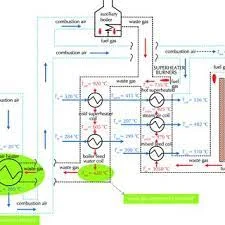Definition: Vapor-liquid separators are crucial components in various process industries for separating entrained liquids from gas streams. Their sizing is critical for ensuring proper separation efficiency and preventing liquid carryover.
Click the Translate button(see right) on this post to set your Own Language to understand more perfectly!!
Vapor-Liquid Separator Sizing Calculator
Vapor-Liquid Separator Sizing Calculator
Continue Definition:
Vapor-Liquid Separator Sizing Properties
Vapor-liquid separators are crucial components in various process industries for separating entrained liquids from gas streams. Their sizing is critical for ensuring proper separation efficiency and preventing liquid carryover. Here's a breakdown of key properties involved in sizing a vapor-liquid separator:
1. Droplet Settling Velocity (Uc):
This property represents the minimum velocity required for a liquid droplet to fall through the gas stream and reach the liquid accumulation zone. It depends on factors like droplet size, gas and liquid densities, and viscosity. The following equation (often used with drag coefficient 'C' obtained from charts) helps calculate Uc:
Uc = [ (2 * g * dp * (ρL - ρg)) / (3 * ρg * C) ]^0.5
where:
Uc = Droplet settling velocity (m/s)
g = Gravitational constant (m/s²)
dp = Droplet diameter (m)
ρL = Liquid density (kg/m³)
ρg = Gas density (kg/m³)
C = Drag coefficient (-)
2. Separator Residence Time:
This represents the minimum time a gas molecule needs to spend inside the separator for effective liquid separation. It's usually expressed as a function of the desired liquid droplet removal efficiency.
3. Separator Diameter (D):
This property is determined by considering factors like gas flow rate, desired residence time, and minimum droplet settling velocity. The Souders-Brown equation, though a simplified approach, offers a starting point for estimating the diameter:
D = (4 * Qg) / (Uc * Vs)
where:
D = Separator diameter (m)
Qg = Gas volumetric flow rate (m³/s)
Vs = Superficial gas velocity through the separator (m/s) (Vs < Uc for proper separation)
4. Separator Height (H):
This property depends on several factors like:
Liquid Hold-up Time: The desired time for the separator to hold the separated liquid before discharge.
Inlet/Outlet Nozzle Sizes: These should be sized to handle the respective flow rates without excessive pressure drop.
Mist Eliminator Presence: If used, the height needs to accommodate the mist eliminator element.
Example:
Consider a separator separating a gas stream with a liquid droplet size of 100 microns (dp = 0.1 mm) from a natural gas (ρg = 1 kg/m³) and condensate (ρL = 700 kg/m³) mixture. The desired gas flow rate is 10 m³/s, and a minimum residence time of 30 seconds is required.
Assuming a drag coefficient (C) of 0.5, calculate the droplet settling velocity (Uc).
Choose a superficial gas velocity (Vs) of 0.5 m/s (ensuring Vs < Uc).
Use the Souders-Brown equation to estimate the separator diameter (D).
Based on the desired liquid hold-up time and gas flow rate, calculate the required liquid hold-up volume.
Determine the separator height (H) considering factors like liquid hold-up volume, minimum height requirements, and presence/absence of a mist eliminator (if applicable).
How can we utilize the vapor-liquid separator sizing Calculation knowledge in real life to EARN MONEY?
Here's how your knowledge of vapor-liquid separator sizing calculations can translate into earning money:
Direct Applications:
Engineering Consultant: Offer your services as a consultant for process plant design or optimization projects. You can help companies size vapor-liquid separators for new installations or troubleshoot problems with existing ones. This can be done freelance or by joining a consulting firm.
Process Engineering Role: Many industries utilize vapor-liquid separators, including oil & gas, chemical, pharmaceutical, and food processing. Having knowledge of separator sizing can be valuable in process engineering roles where you'd be involved in designing or optimizing process equipment.
Equipment Sales & Manufacturing: Understanding separator sizing calculations can be beneficial if you work in sales or manufacturing of separators. This knowledge allows you to:
Effectively recommend the right size separator for customer needs.
Assist in troubleshooting customer issues related to separator performance.
Contribute to the development and improvement of separator designs.
Indirect Applications:
Freelance Design & Troubleshooting Services: Offer online or local services for basic separator sizing calculations or troubleshooting for smaller projects.
Training & Knowledge Sharing: Create online courses or workshops to teach others about vapor-liquid separator sizing calculations. This can be targeted towards engineering students, professionals seeking upskilling, or specific industries.
Develop Software or Tools: If you have programming skills, consider developing software or online tools that automate vapor-liquid separator sizing calculations.
Additional Points:
Combine Expertise: For higher earning potential, combine your knowledge of separator sizing with expertise in other areas like process simulation, computational fluid dynamics (CFD), or specific industry regulations.
Networking & Marketing: Regardless of the path you choose, building a strong network within relevant industries and effectively marketing your skills are crucial for attracting clients or finding the right job.
By effectively utilizing your knowledge and developing your skillset, you can leverage vapor-liquid separator sizing calculations into a valuable tool for earning money in various ways.
Do YOU Want To Earn Money In Various Ways, Click The Link & Explore Your Field of Interest!!!









No comments:
Post a Comment